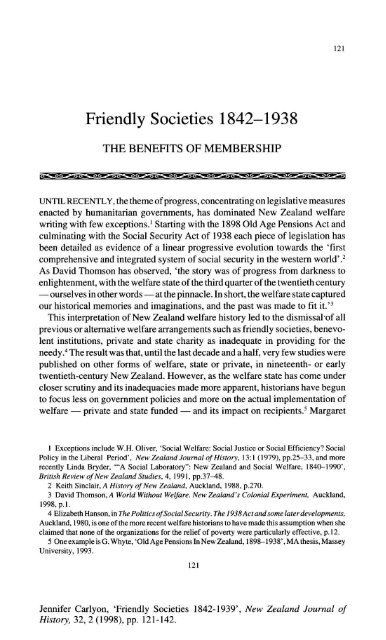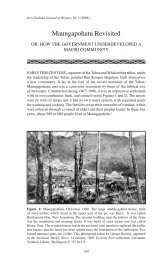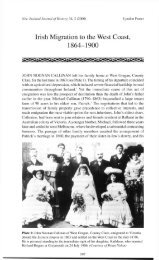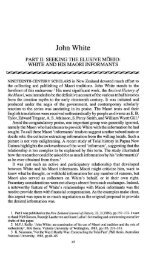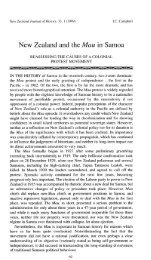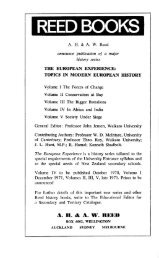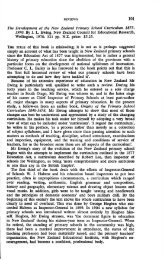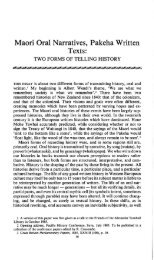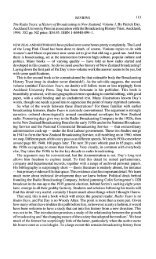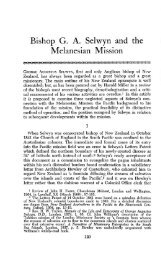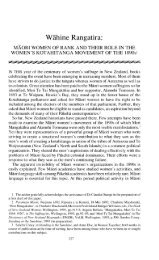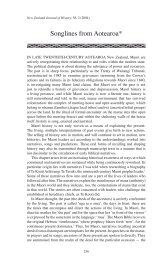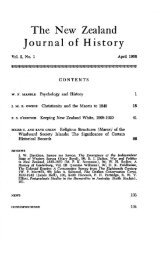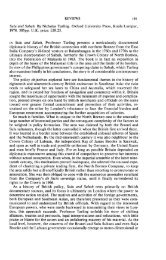Friendly Societies 1842-1938 - New Zealand Journal of History ...
Friendly Societies 1842-1938 - New Zealand Journal of History ...
Friendly Societies 1842-1938 - New Zealand Journal of History ...
Create successful ePaper yourself
Turn your PDF publications into a flip-book with our unique Google optimized e-Paper software.
<strong>Friendly</strong> <strong>Societies</strong> <strong>1842</strong>-<strong>1938</strong><br />
THE BENEFITS OF MEMBERSHIP<br />
UNTIL RECENTLY, the theme <strong>of</strong> progress, concentrating on legislative measures<br />
enacted by humanitarian governments, has dominated <strong>New</strong> <strong>Zealand</strong> welfare<br />
writing with few exceptions. 1 Starting with the 1898 Old Age Pensions Act and<br />
culminating with the Social Security Act <strong>of</strong> <strong>1938</strong> each piece <strong>of</strong> legislation has<br />
been detailed as evidence <strong>of</strong> a linear progressive evolution towards the 'first<br />
comprehensive and integrated system <strong>of</strong> social security in the western world' , 2<br />
As David Thomson has observed, 'the story was <strong>of</strong> progress from darkness to<br />
enlightenment, with the welfare state <strong>of</strong> the third quarter <strong>of</strong> the twentieth century<br />
— ourselves in other words — at the pinnacle. In short, the welfare state captured<br />
our historical memories and imaginations, and the past was made to fit it.' 3<br />
This interpretation <strong>of</strong> <strong>New</strong> <strong>Zealand</strong> welfare history led to the dismissal <strong>of</strong> all<br />
previous or alternative welfare arrangements such as friendly societies, benevolent<br />
institutions, private and state charity as inadequate in providing for the<br />
needy. 4 The result was that, until the last decade and a half, very few studies were<br />
published on other forms <strong>of</strong> welfare, state or private, in nineteenth- or early<br />
twentieth-century <strong>New</strong> <strong>Zealand</strong>. However, as the welfare state has come under<br />
closer scrutiny and its inadequacies made more apparent, historians have begun<br />
to focus less on government policies and more on the actual implementation <strong>of</strong><br />
welfare — private and state funded — and its impact on recipients. 5 Margaret<br />
1 Exceptions include W.H. Oliver, 'Social Welfare: Social Justice or Social Efficiency? Social<br />
Policy in the Liberal Period', <strong>New</strong> <strong>Zealand</strong> <strong>Journal</strong> <strong>of</strong> <strong>History</strong>, 13:1 (1979), pp.25-33, and more<br />
recently Linda Bryder, '"A Social Laboratory": <strong>New</strong> <strong>Zealand</strong> and Social Welfare, 1840-1990',<br />
British Review <strong>of</strong> <strong>New</strong> <strong>Zealand</strong> Studies, 4, 1991, pp.37^18.<br />
2 Keith Sinclair, A <strong>History</strong> <strong>of</strong> <strong>New</strong> <strong>Zealand</strong>, Auckland, 1988, p.270.<br />
3 David Thomson, A World Without Welfare. <strong>New</strong> <strong>Zealand</strong>'s Colonial Experiment, Auckland,<br />
1998, p.l.<br />
4 Elizabeth Hanson, in The Politics <strong>of</strong> Social Security. The <strong>1938</strong>Act and some later developments,<br />
Auckland, 1980, is one <strong>of</strong> the more recent welfare historians to have made this assumption when she<br />
claimed that none <strong>of</strong> the organizations for the relief <strong>of</strong> poverty were particularly effective, p. 12.<br />
5 One example is G. Whyte, 'Old Age Pensions In <strong>New</strong> <strong>Zealand</strong>, 1898-<strong>1938</strong>', MA thesis, Massey<br />
University, 1993.<br />
121<br />
Jennifer Carlyon, '<strong>Friendly</strong> <strong>Societies</strong> <strong>1842</strong>-1939', <strong>New</strong> <strong>Zealand</strong> <strong>Journal</strong> <strong>of</strong><br />
<strong>History</strong>, 32, 2 (1998), pp. 121-142.
122 JENNIFER CARL YON<br />
Tennant's Paupers and Providers: Charitable Aid in <strong>New</strong> <strong>Zealand</strong>, is one such<br />
investigation. 6 Although a study <strong>of</strong> statutory welfare arrangements, it looks<br />
beyond the intent <strong>of</strong> the legislation to assess the implementation <strong>of</strong> charitable aid<br />
and its impact on beneficiaries. A more general investigation into the ways in<br />
which the <strong>New</strong> <strong>Zealand</strong> people sought to protect themselves against need in old<br />
age in the nineteenth and early twentieth centuries has been undertaken by David<br />
Thomson in A World Without Welfare, <strong>New</strong> <strong>Zealand</strong>'s Colonial Experiment?<br />
Before this last decade, friendly societies had been generally either ignored by<br />
historians or, with one exception, dismissed as insignificant because <strong>of</strong> the<br />
limitations placed on membership — specifically that only those in good health<br />
who could maintain the regular contributions could afford to be members. 8<br />
Typical <strong>of</strong> the latter approach is Heather Shepherd who, in her 1976 research<br />
exercise on friendly societies in late nineteenth-century <strong>New</strong> <strong>Zealand</strong>, describes<br />
them as having little impact on <strong>New</strong> <strong>Zealand</strong> society. 9 She argues that by the end<br />
<strong>of</strong> the first decade <strong>of</strong> the twentieth century the movement had begun to falter. Yet<br />
it was in fact during the first three decades <strong>of</strong> the twentieth century that friendly<br />
societies experienced their greatest expansion and that financial stability was<br />
finally achieved. <strong>New</strong> benefit funds were set up to enable their members to have<br />
access to the increasingly sophisticated medical technology being used in<br />
hospitals, and United <strong>Friendly</strong> Society (UFS) pharmacies were set up throughout<br />
the country. Membership had risen from 41,236 members in 1901 to 113,709 by<br />
<strong>1938</strong>. Although this figure represented only 11% <strong>of</strong> the adult population,<br />
friendly society benefits were extended to spouses and children, which meant<br />
that by this date approximately 20% <strong>of</strong> the total population benefited from these<br />
mutual aid societies.<br />
More recently this negative assessment <strong>of</strong> friendly societies has been restated<br />
by David Thomson. In an article investigating thrift in nineteenth-century <strong>New</strong><br />
<strong>Zealand</strong> he concludes that friendly societies were 'weak and irrelevant' and<br />
unable to deliver what they promised due to financial insolvency. 10 He argues<br />
that they were financially unsound, that 'they never had the resources to match<br />
their promises'; this was, in his view, 'the "dark secret" <strong>of</strong> friendly societies<br />
everywhere'. He goes on to contend that the friendly societies themselves<br />
persisted in ignoring the evidence and continued to 'promise high and charge low'.<br />
While this assertion is true for the nineteenth century it was manifestly<br />
6 Wellington, 1989.<br />
7 Auckland, 1998.<br />
8 An exception is J.K. Hoar, 'A Descriptive <strong>History</strong> <strong>of</strong> the Major Aspects <strong>of</strong> the <strong>Friendly</strong> Society<br />
Movement in <strong>New</strong> <strong>Zealand</strong> 1840-1900', MA thesis, The University <strong>of</strong> Idaho Graduate School, 1963,<br />
which shows that they were an important part <strong>of</strong> the 'common man's' life, providing a source <strong>of</strong><br />
insurance against unexpected adversities as well as a focal point for social and recreational activities.<br />
9 Heather Shepherd, 'The Nature and Role <strong>of</strong> <strong>Friendly</strong> <strong>Societies</strong> in Later Nineteenth Century <strong>New</strong><br />
<strong>Zealand</strong>', BA (Hons) Research Exercise, Massey University, 1976.<br />
10 David Thomson, 'Colonial Thrift', <strong>History</strong> Now, 3,1 (1997), pp.8-13.
FRIENDLY SOCIETIES <strong>1842</strong>-<strong>1938</strong> 123<br />
incorrect by 1915. The friendly societies themselves were only too aware <strong>of</strong> the<br />
dangers <strong>of</strong> insolvency, and the large societies such as Manchester Unity<br />
Independent Order <strong>of</strong> Oddfellows (MUIOOF), Independent Order <strong>of</strong> Oddfellows<br />
(IOOF), Ancient Order <strong>of</strong> Foresters (AOF), and United Ancient Order <strong>of</strong> Druids<br />
(UAOD), pushed along by the registrars, worked hard to remedy the problem and<br />
to bring contributions and benefits into line. By 1915 the registrar was able to<br />
comment that 'the great majority <strong>of</strong> societies are either quite sound actuarially<br />
or are approaching that condition'. 11<br />
Thomson also underlines the inadequacy <strong>of</strong> what he calls 'the ludicrously<br />
small risk-sharing pool', and argues that each small branch kept and managed its<br />
own funds, bearing most <strong>of</strong> the risks and expenditures in return. In fact, the large<br />
societies recognized the danger <strong>of</strong> 'small risk pools' and worked towards<br />
consolidating their funds. By the turn <strong>of</strong> the century all the large societies had<br />
consolidated their funeral funds at district level and were beginning to discuss<br />
ways and means <strong>of</strong> consolidating sick funds. By 1915, as evidenced by the<br />
actuary' s comments, the move towards sick fund consolidation was under way. 12<br />
By <strong>1938</strong> at least 70% <strong>of</strong> all friendly society sick funds had also been consolidated,<br />
thereby ensuring that if a lodge with only a small membership had a<br />
disproportionately large claim it would not suffer financially.<br />
Thomson further claims that because the societies <strong>of</strong>fered few benefits, not<br />
covering unemployment or providing pensions for old age, their value was<br />
limited. 13 While it is true that there was no formal old age pension or unemployment<br />
fund, as my article will show, the societies abandoned neither the unemployed<br />
nor the aged, but found different means <strong>of</strong> helping them. Furthermore, friendly<br />
societies <strong>of</strong>fered a wide range <strong>of</strong> benefits, adding and adapting benefits as<br />
conditions changed and different needs became apparent. Medical schemes,<br />
hospital funds, dispensaries, benevolent funds, funds to support widows and<br />
orphans and, during the depression, funds to help the unemployed members were<br />
all added to the basic sickness and funeral funds and provision <strong>of</strong> medical treatment.<br />
By means <strong>of</strong> these many benefits friendly society assistance was extended<br />
to the whole family and was an effective form <strong>of</strong> relief in times <strong>of</strong> need for a<br />
certain section <strong>of</strong> the population. Moreover, becoming a member <strong>of</strong> a friendly<br />
society meantjoining a fellowship committed mutually to assisting and supporting<br />
one another whatever the circumstances, whatever the need. As both Hoar and<br />
Olssen have emphasized, this aspect <strong>of</strong> social support was a significant factor in<br />
making friendly societies an important focus in many working people's lives. 14<br />
11 Appendices to the <strong>Journal</strong>s <strong>of</strong> the House <strong>of</strong> Representatives (AJHR), 1915, H-l, p.8.<br />
12 ibid.<br />
13 Thomson, 'Colonial Thrift', p.9.<br />
14 Hoar, pp.104-6. E. Olssen, '<strong>Friendly</strong> <strong>Societies</strong> in <strong>New</strong> <strong>Zealand</strong> 1840-1990', in Marcel van<br />
der Linden, ed., Social Security Mutualism. The Comparative <strong>History</strong> <strong>of</strong> Mutual Benefit <strong>Societies</strong>,<br />
Berne, 1996, pp. 177-206.
124 JENNIFER CARL YON<br />
In contrast to Thomson, David Green has presented an overly positive picture<br />
<strong>of</strong> friendly societies both in <strong>New</strong> <strong>Zealand</strong> and elsewhere. 15 He has held them up<br />
as exemplars <strong>of</strong> the Victorian virtues <strong>of</strong> thrift, mutual support and independent<br />
self-help. Green maintains that these associations <strong>of</strong>fered superior quality<br />
services and provided opportunities for developing the personal skills 'necessary<br />
for liberty and independence'. He argues that the welfare state has eroded any<br />
sense <strong>of</strong> personal responsibility and mutual obligation. Without any real historical<br />
research or in-depth investigation into <strong>New</strong> <strong>Zealand</strong> friendly societies, he<br />
recommends that a solution to the present welfare dependency would be to move<br />
welfare away from the state and once again make it the responsibility <strong>of</strong><br />
individuals to organize their own independent welfare provision through voluntary<br />
mutual aid associations such as the friendly societies. 16<br />
While I believe that, in his determination to highlight the inadequacies <strong>of</strong> the<br />
welfare state, Green has painted a too uncritical picture <strong>of</strong> friendly societies and<br />
has overstated their role and impact, Thomson conversely has focused only on<br />
their limitations, which has led him to dismiss almost completely their relevance<br />
and usefulness in the lives <strong>of</strong> many working people before <strong>1938</strong>. I hope this<br />
article will go some way towards redressing the balance.<br />
In an era when there were no state income maintenance schemes and any state<br />
provision <strong>of</strong> welfare was limited and restrictive, for the skilled workers who<br />
could afford regular contributions, friendly societies were one <strong>of</strong> the most<br />
comprehensive forms <strong>of</strong> insurance against the calamitous effects <strong>of</strong> illness or<br />
accident to the wage earner. The rules <strong>of</strong> the United Ancient Order <strong>of</strong> Druids,<br />
which are representative <strong>of</strong> all friendly societies, illustrate the wide range <strong>of</strong><br />
assistance <strong>of</strong>fered to members. They aimed:<br />
(1) To provide a certain weekly allowance in case <strong>of</strong> sickness or accident to contributing<br />
members.<br />
(2) To provide as may be agreed upon with the Lodge Medical Officer surgical aid and<br />
medicine to members, their wives and children; and to the widowed mothers <strong>of</strong><br />
unmarried members; and the widows and children <strong>of</strong> deceased members.<br />
(3) To provide a certain sum on the death <strong>of</strong> a member or his wife, and also in certain<br />
cases, the widow <strong>of</strong> a late member, for the purposes <strong>of</strong> paying the burial expenses.<br />
15 David Green, Working-Class Patients and the Medical Establishment. Self-help in Britain<br />
from the mid-nineteenth century to 1948, Aldershott, 1985. David Green and Lawrence G. Cromwell,<br />
Mutual Aid or Welfare State, Australia's <strong>Friendly</strong> <strong>Societies</strong>, Sydney, 1984.<br />
16 David Green, From Welfare State to Civil Society. Welfare that Works in <strong>New</strong> <strong>Zealand</strong>,<br />
Wellington, 1996. He based his assumptions about <strong>New</strong> <strong>Zealand</strong> friendly societies largely on his<br />
research into Australian and British friendly societies. He also recommended the same solution to<br />
British welfare problems in David Green, Reinventing Civil Society. The Rediscovery <strong>of</strong> Welfare<br />
without Politics, London, 1993.
FRIENDLY SOCIETIES <strong>1842</strong>-<strong>1938</strong> 125<br />
(4) To provide temporary relief or maintenance for widows and children <strong>of</strong> deceased<br />
members.<br />
(5) To provide for the relief or maintenance <strong>of</strong> members in distressed circumstances. 17<br />
By banding together, setting up benefit funds and pledging mutually to assist one<br />
another in time <strong>of</strong> need, the friendly society members represented the ideals <strong>of</strong><br />
thrift, self-help and independence so lauded by the policy makers <strong>of</strong> the<br />
nineteenth and early twentieth centuries. By making regular contributions into<br />
a common fund from which, in the event <strong>of</strong> inability to work, a small weekly<br />
allowance could be drawn, members were assured <strong>of</strong> avoiding destitution and<br />
having to turn to the state for relief. Further funds were created to meet the cost<br />
<strong>of</strong> medical care for the member and the family. In the event <strong>of</strong> death <strong>of</strong> either the<br />
member, his wife or a child, a payment <strong>of</strong> a fixed sum was made to cover the costs<br />
<strong>of</strong> the funeral and provide a certain amount <strong>of</strong> financial relief to the bereaved. 18<br />
Additional miscellaneous aid was dispensed on an ad hoc basis as need arose,<br />
extra funds being raised by various means such as subscription lists, benefit<br />
concerts, charity balls, theatricals and levies. Membership <strong>of</strong> a friendly society<br />
meant kinship where every person was pledged to help all other members and<br />
their families. It was this fraternal bond, expressed in the following words spoken<br />
to new members <strong>of</strong> the Ancient Order <strong>of</strong> Foresters during the initiation ceremony,<br />
that characterized the friendly societies and set them apart from other<br />
insurance schemes: 'You are about to become by your own free will members<br />
<strong>of</strong> a society that is united for the purpose <strong>of</strong> promoting the well-being <strong>of</strong> each<br />
other. We feel and know that we are not born for ourselves alone and recognising<br />
the duties and responsibilities <strong>of</strong> the social condition we are desirous by<br />
association to relieve distress, aid the weak and comfort the mourner .... The<br />
word <strong>of</strong> the Forester expresses the active interest we take in the welfare <strong>of</strong> our<br />
brethren and our readiness to share their burdens and relieve their distresses.' 19<br />
In England friendly societies established by working-class members for their<br />
own mutual self-help continued to draw the large percentage <strong>of</strong> their membership<br />
from the more skilled sections <strong>of</strong> this class. 20 It has been assumed that <strong>New</strong><br />
<strong>Zealand</strong> friendly societies had the same membership composition. David Thomson<br />
and Caroline Daley have both made impressionistic analyses <strong>of</strong> membership<br />
17 Rules <strong>of</strong> the United Ancient Order <strong>of</strong> Druids, (<strong>Friendly</strong> Society), Grand Lodge <strong>of</strong> the North<br />
Island <strong>of</strong> <strong>New</strong> <strong>Zealand</strong> and its Branches, Wellington, 1921 p.4.<br />
18 Men were able to insure the lives <strong>of</strong> their wives; however, when women started becoming<br />
members at the turn <strong>of</strong> the century they were unable, right up until the 1950s, to insure the lives <strong>of</strong><br />
their husbands.<br />
19 Formularies and Lectures <strong>of</strong> the Ancient Order <strong>of</strong> Foresters <strong>Friendly</strong> Society, 1930, pp. 19-<br />
21.<br />
20 See Peter Gosden, The <strong>Friendly</strong> <strong>Societies</strong> in England, 1815-1875, London, 1961, pp.71-88,<br />
for an analysis <strong>of</strong> English membership.
126 JENNIFER CARL YON<br />
characteristics which confirm this assumption. 21 In a more detailed quantitative<br />
analysis <strong>of</strong> membership occupations <strong>of</strong> four Dunedin lodges, Olssen suggests<br />
that the occupational composition <strong>of</strong> these lodges was drawn from a wider social<br />
range. 22 More broad-based investigation is required before any definite conclusions<br />
can be drawn on the social composition <strong>of</strong> the lodges.<br />
With the exception <strong>of</strong> the two temperance societies, the Rechabites and<br />
Templars, membership was initially restricted to men. By the 1890s, in response<br />
to requests to allow women membership, separate but parallel lodges for women<br />
were established. The Wellington District AOF led the way with the institution<br />
<strong>of</strong> two courts for women in 1894. The IOOF followed in October 1895 with the<br />
establishment <strong>of</strong> its first Rebekah Lodge, the name given to its women's lodges,<br />
and MUIOOF, Wellington, opened a lodge for women in November <strong>of</strong> that year.<br />
The move towards mixed lodges started at the end <strong>of</strong> the first decade <strong>of</strong> the<br />
twentieth century, but gained no real momentum until the mid 1920s because it<br />
was <strong>of</strong>ten strongly resisted by male members, particularly by older men as they<br />
thought the inclusion <strong>of</strong> women would curtail their social activities. By the late<br />
1930s nearly all the MUIOOF and AOF city lodges were mixed, while rural<br />
lodges were slower to follow. However, the number <strong>of</strong> women joining friendly<br />
societies before the late 1930s was never very significant. They were mainly<br />
young working women who tended to drop their membership when they married.<br />
Every <strong>New</strong> <strong>Zealand</strong> friendly society <strong>of</strong>fered the same basic benefits and while<br />
there was some variation in contributions, benefits paid, procedures <strong>of</strong> payment<br />
and selection <strong>of</strong> members, the <strong>New</strong> <strong>Zealand</strong> friendly societies all operated along<br />
similar lines. With few exceptions, the societies established in <strong>New</strong> <strong>Zealand</strong><br />
were branches <strong>of</strong> the large English organizations such as Manchester Unity,<br />
Ancient Order <strong>of</strong> Foresters, Druids and others. The first lodges were generally<br />
set up by men who had been members in England, the very earliest being the<br />
Nelson Lodge, formed on 6 November 1841, by members <strong>of</strong> the Manchester<br />
Unity who arrived on the Martha Ridgeway from Liverpool. Accordingly, the<br />
English rule books were used and the system <strong>of</strong> contributions and benefits varied<br />
little, if at all, from those already set in place in the 'Mother Country'. 23<br />
The first step to receiving these benefits was to become a friendly society<br />
21 C. Daley, 'Gender in the Community: A study <strong>of</strong> the women and men <strong>of</strong> the Taradale Area,<br />
1886-1930', PhD thesis, Victoria University <strong>of</strong> Wellington, 1992, p.226. Thomson,/! World with<br />
Welfare, p.48.<br />
22 Olssen, pp. 195-9. The different friendly societies had different names for their local branches.<br />
Many, such as Manchester Unity, The Independent Order <strong>of</strong> Oddfellows and Druids, called them<br />
lodges. The Ancient Order <strong>of</strong> Foresters had Courts; the Rechabites, Tents.<br />
23 In spite <strong>of</strong> small adjustments and changes to the rules, benefits and contributions over the years<br />
to accommodate changing costs, conditions <strong>of</strong> living and conformity with <strong>New</strong> <strong>Zealand</strong> government<br />
regulations, the rules <strong>of</strong> the late 1930s were remarkably similar to those <strong>of</strong> the 1860s, and<br />
consequently remained almost identical to their English counterparts.
FRIENDLY SOCIETIES <strong>1842</strong>-<strong>1938</strong> 127<br />
member, this process being considerably more involved than simply filling in the<br />
application form and paying the fee. Given the importance placed on fellowship<br />
and mutual caring, no friendly society wanted members who would be unwilling<br />
or unable to embrace these principles. Respectability was an important part <strong>of</strong> the<br />
friendly society ethos. A strong moral code was adopted by all the societies and<br />
every member was expected to abide by it. The preface to the 1890 rules <strong>of</strong> the<br />
AOF Taranaki District illustrates very precisely what sort <strong>of</strong> a man the friendly<br />
societies expected their members to be: 'A good Forester is a man who, jealous<br />
<strong>of</strong> his rights as a citizen, maintains them in a temperate manly and decorous<br />
manner; at the same time he knows his duties too, performs them well, and pays<br />
a ready and willing obedience to his country's laws neither cringing nor servile<br />
on the one hand, nor wild nor factious on the other. In his private character, as<br />
father, son, or husband he fulfils their relative claims with scrupulous fidelity.<br />
Benevolence and friendship are our objects, and justice and morality are our<br />
characteristics.' 24 To minimise the risk <strong>of</strong> a morally 'undesirable' applicant<br />
becoming a member and to protect their reputation <strong>of</strong> having only respectable,<br />
honest, moral, hardworking wage earners, every friendly society insisted that a<br />
potential member had to be proposed by one member, seconded by another and<br />
then voted on by the whole lodge. Even then, further checks were carried out.<br />
Once voted on by the lodge, a small committee <strong>of</strong> members would investigate<br />
the candidate to 'ascertain that the person proposed is <strong>of</strong> good moral character<br />
and sober habits' , 25 In principle any person 'who bears a bad character, leads a<br />
dissolute life, frequents bad company, is guilty <strong>of</strong> habitual intoxication, or is <strong>of</strong><br />
a quarrelsome behaviour.. ,' 26 would not be admitted to membership. In reality<br />
<strong>of</strong> course, as reports and lodge minute books show, lodges were not always<br />
successful in limiting membership to only the respectable members <strong>of</strong> the<br />
community. On occasion treasurers or secretaries absconded with the funds and,<br />
particularly in the early years, there were <strong>of</strong>ten references to members being<br />
drunk. Once the good moral character <strong>of</strong> the candidate had been attested to, the<br />
next stage was a medical examination to ascertain that the potential member was<br />
in good health and, if a married man, a declaration as to his wife's health. This<br />
was essential because no lodge wanted to admit a member who would be a<br />
potential financial liability.<br />
When all investigations were completed, and medical certificates and declarations<br />
filled in, the candidate was eligible to undergo the ceremony <strong>of</strong> initiation<br />
into the chosen lodge. No person could become a member and benefit from the<br />
funds without undergoing this vitally important ceremony, for there was more<br />
24 General Laws for the Government <strong>of</strong> the Taranaki Ancient Order <strong>of</strong> Foresters, <strong>New</strong> Plymouth,<br />
1890, p.5.<br />
25 Rules <strong>of</strong> the Taranaki, <strong>New</strong> <strong>Zealand</strong>, District <strong>of</strong> the Ancient Order <strong>of</strong> Foresters, Taranaki,<br />
1933, rule 2, p.22.<br />
26 ibid., rule 5, p.23.
128 JENNIFER CARL YON<br />
to becoming a friendly society member than just paying the money and receiving<br />
the benefits. It meant becoming part <strong>of</strong> a mutually supportive group where the<br />
axioms <strong>of</strong> mutual help and responsibility for the well-being <strong>of</strong> others were<br />
obligations to be taken seriously. Every friendly society, without exception, was<br />
underpinned by this fundamental belief in the mutual assurance <strong>of</strong> the well-being<br />
<strong>of</strong> fellow-members and their families. The initiation ritual served as a kind <strong>of</strong><br />
baptism which formally marked the entrance <strong>of</strong> the member into the new group<br />
and introduced this new 'brother' or 'sister' to the rules and ethics <strong>of</strong> the society.<br />
Once initiated into one lodge, all the large affiliated societies such as<br />
MUIOOF, AOF, Druids and IOOF, allowed transferral <strong>of</strong> membership to<br />
another lodge <strong>of</strong> the same friendly society anywhere in <strong>New</strong> <strong>Zealand</strong> or overseas.<br />
Provided the member was up to date with contributions and had not transgressed<br />
any ethical code <strong>of</strong> the society, transferral <strong>of</strong> membership without losing any <strong>of</strong><br />
the accrued benefits was a simple and easy procedure. Given the particularly<br />
mobile colonial workforce and high level <strong>of</strong> immigration and emigration<br />
throughout the nineteenth century this transferability <strong>of</strong> benefits was essential to<br />
friendly society members.<br />
Contributions, benefits and conditions <strong>of</strong> payment varied from one friendly<br />
society to another, the most common practice being for a member to pay a<br />
combined contribution for the sickness and funeral benefit either fortnightly or<br />
monthly and, if they wished, a further sum for medical care. From the 1840s to<br />
the 1880s contributions were generally low and uniform, supplemented by a<br />
large initiation fee. The Fountain <strong>of</strong> Friendship Lodge, MUIOOF, Auckland,<br />
was a typical example. In 1844 contributions were fixed at sixpence weekly for<br />
all members regardless <strong>of</strong> age. The initiation fee was graduated according to age,<br />
with members under 21 paying 10s.6d., those under 30 years <strong>of</strong> age 15s., and<br />
those aged between 30 and 40 years paying 21s. By the late 1890s most friendly<br />
societies, under pressure from the registrar, 27 had introduced a graduated scale<br />
<strong>of</strong> contributions to the sick and funeral funds. While the amounts paid in<br />
contributions varied slightly from one society to another the average contribution<br />
in 1890 was sixpence a week for male members under 21, rising to Is. per<br />
week for members between 30 and 40 years old. By <strong>1938</strong> these contributions had<br />
risen very slightly to eightpence per week and Is.3d. respectively. 28 Female<br />
members paid less in the way <strong>of</strong> contributions and received correspondingly<br />
smaller benefits.<br />
27 Throughout the nineteenth, and well into the twentieth century, the Registrar <strong>of</strong> <strong>Friendly</strong><br />
<strong>Societies</strong> continually exhorted the societies to compile and use realistic tables <strong>of</strong> contributions and<br />
benefits, with the objective <strong>of</strong> becoming actuarially sound. By the end <strong>of</strong> the first decade <strong>of</strong> the<br />
twentieth century most <strong>of</strong> the larger societies had become solvent.<br />
28 Based on tables <strong>of</strong> contributions in Manchester Unity Independent Order <strong>of</strong> Oddfellows (<strong>New</strong><br />
<strong>Zealand</strong>) <strong>Friendly</strong> Society. Special Rules <strong>of</strong> the Auckland District, Auckland, 1944, pp.22-24.
FRIENDLY SOCIETIES <strong>1842</strong>-<strong>1938</strong> 129<br />
The basic sickness benefit covered all illnesses and temporary or permanent<br />
disabilities resulting from accidents. In the nineteenth and early twentieth<br />
centuries membership <strong>of</strong> a friendly society was the only way a family could be<br />
assured <strong>of</strong> some form <strong>of</strong> continued income should the main breadwinner be<br />
unable to work for any length <strong>of</strong> time. By the 1880s all the friendly society male<br />
members were paid 20s. per week for the first 12 months <strong>of</strong> illness, and thereafter<br />
some, such as MUIOOF, paid 10s. for the remainder <strong>of</strong> the illness. 29 Other<br />
societies such as the Druids paid 10s. per week for the next six months after which<br />
the benefit reduced to 7s. for as long as the illness continued. 30 Female members<br />
received 10s. a week for the first six months' sickness and 5 s. per week thereafter.<br />
Sickness benefits were frequently paid over extended periods <strong>of</strong> time to older<br />
members who could not continue to work as a result <strong>of</strong> chronic illnesses<br />
associated with old age. This served as a de facto pension, and compared<br />
favourably with the state old age pension, the maximum entitlement <strong>of</strong> which<br />
was 7s. per week in 1898, rising to 10s. per week in 1905. 31 Because these longterm<br />
payments were a drain on lodge funds the creation <strong>of</strong> friendly society<br />
superannuation schemes was <strong>of</strong>ten investigated and discussed by the societies<br />
though never implemented. There was never sufficient support from the members<br />
to adopt such schemes, probably because the contributions required would<br />
have been too burdensome. Apart from this prolonged sick pay, the ways and<br />
means societies supported their aged members varied according to the means <strong>of</strong><br />
each lodge. For many lodges using part <strong>of</strong> any surplus funds showing at-their<br />
quinquennium valuation to pay the sickness and funeral contributions <strong>of</strong> members<br />
over the age <strong>of</strong> 65 became standard procedure. For others, grants were given<br />
from the lodge benevolent fund to aged members who had become financially<br />
distressed. Although this support for their aged members was ad hoc, and in some<br />
cases only granted when the need was dire, it was never considered to be charity,<br />
but a right the old members had earned over the years.<br />
After the 1890s there were no more adjustments to the sick benefit to keep pace<br />
with the changing cost <strong>of</strong> living and these same rates <strong>of</strong> pay were still in force<br />
in 1951. As David Thomson has pointed out, the relative value <strong>of</strong> sick pay fell<br />
markedly over time. In the early twentieth century the friendly society sick pay<br />
did not increase at all, whereas both wages and prices started a sustained rise and<br />
continued to rise throughout the first decades <strong>of</strong> the century, until, by 1920,<br />
consumer prices and wages had almost doubled from their levels in the mid-<br />
1890s. 32 In 1885 in the Auckland district skilled labourers such as masons,<br />
29 ibid., pp.15-16.<br />
30 Rules <strong>of</strong> the United Ancient Order <strong>of</strong> Druids, (<strong>Friendly</strong> Society). Grand Lodge <strong>of</strong> the North<br />
Island <strong>of</strong> <strong>New</strong> <strong>Zealand</strong> and its Branches, Wellington, 1921, pp. 70-71.<br />
31 See Whyte, who explores in detail the implementation <strong>of</strong> old age pensions policy in <strong>New</strong><br />
<strong>Zealand</strong>.<br />
32 Thomson, A World Without Welfare, pp.43^4.
130 JENNIFER CARL YON<br />
plumbers and carpenters were receiving a weekly wage <strong>of</strong> up to 66s., general<br />
labourers 45s., bakers 45s., and farm labourers 20s. 33 By 1925 the minimum<br />
weekly award rates <strong>of</strong> pay were for bakers 99s., masons, carpenters and plumbers<br />
between 96s. and 99s., for general labourers 75s. and for farm labourers 55s. 34<br />
The sick rate, which in the 1880s had compared favourably with the minimum<br />
weekly wage rates, was by the 1920s, worth considerably less. Nevertheless, it<br />
must be remembered that even with the considerable drop in real worth <strong>of</strong> the<br />
friendly society sickness benefits by the 1920s, it was the only affordable way<br />
in which many working people could be assured <strong>of</strong> some income, albeit reduced,<br />
in time <strong>of</strong> need. The effects <strong>of</strong> accident or ill health could be calamitous for<br />
workers and their families, pushing them into abject poverty and forcing them<br />
to apply for public relief. As Tennant has described, having to prove genuine<br />
need to relieving <strong>of</strong>ficers was <strong>of</strong>ten a humiliating and degrading experience, and<br />
if relief was granted it was frequently given in kind, with the stigma <strong>of</strong> charity<br />
attached. 35 The friendly society cash benefit, small though it was, was not<br />
charity, but a right, earned by paying regular contributions into a fund.<br />
Because a sound sickness fund was critical to the financial health <strong>of</strong> the lodge<br />
every precaution was taken to prevent any imposition on the funds. Strict rules<br />
regulating the sick benefit were put in place and usually rigidly enforced. 36 For<br />
a member to be able to claim the benefit, first an examination by the lodge doctor<br />
was necessary, after which the doctor was required to sign a standard certificate<br />
<strong>of</strong> ill health and immediately forward it to the secretary <strong>of</strong> the lodge. The doctor<br />
was then expected to keep a close eye on the patient for the duration <strong>of</strong> the illness,<br />
sign a sick attendance sheet to enable the member to continue to receive the<br />
benefit every week and to report, either in person or in writing, to the fortnightly<br />
lodge meeting on the sick member's state <strong>of</strong> health. If the patient was able, a<br />
twice weekly visit to the doctor was mandatory. 'Any member failing to visit the<br />
Medical Officer <strong>of</strong> the Lodge as aforesaid shall be liable to a fine <strong>of</strong> five shillings<br />
unless satisfactory reasons be given for not complying with this clause. ' 37 Should<br />
the member be unable to visit the doctor then 'It shall be the duty <strong>of</strong> the medical<br />
<strong>of</strong>ficer to attend the sick member at his residence at least once in every week.' 38<br />
All claims were closely vetted at the fortnightly lodge meeting, and passed for<br />
payment providing the claimant had not breached any <strong>of</strong> the lodge rules. Not<br />
33 Statistics <strong>of</strong> <strong>New</strong> <strong>Zealand</strong>, Wellington, 1885, p.203.<br />
34 ibid., 1926, p.57.<br />
35 Tennant, particularly chapters 5 and 9.<br />
36 As the rules regulating the sickness benefit were standard amongst all the Orders, and remained<br />
virtually unchanged from the 1850s to 1940s, except where specified, the above description is based<br />
on the General Laws <strong>of</strong> the Ancient Order <strong>of</strong> Foresters, Hawkes Bay District, 1883.<br />
37 Rules <strong>of</strong> the Loyal Remuera Lodge, No.8785, <strong>of</strong> the Auckland District <strong>of</strong> the <strong>New</strong> <strong>Zealand</strong><br />
Branch Manchester Unity Independent Order <strong>of</strong> Oddfellows <strong>Friendly</strong> Society, 1913, Auckland,<br />
1913, p.22.<br />
38 Rules <strong>of</strong> the Ancient Order <strong>of</strong> Foresters, Court Takapuna, Auckland, 1929, p.41.
FRIENDLY SOCIETIES <strong>1842</strong>-<strong>1938</strong> 131<br />
even the most regular contributor could expect to draw a benefit from the lodge<br />
funds if the illness or accident was caused 'by fighting ... or any intemperate,<br />
improper, or immoral conduct or by running, leaping, wrestling or act <strong>of</strong> bravado<br />
... [or by] venereal disease'. 39 Should there be the slightest suspicion that the<br />
illness or accident had been caused by intemperate behaviour, a thorough<br />
investigation into the conduct <strong>of</strong> the claimant was carried out before any payment<br />
was made. Brother Robinson <strong>of</strong> the Protestant Alliance <strong>Friendly</strong> Society (PAFS)<br />
was turned down after a lengthy inquiry over successive lodge nights because he<br />
was deemed to have 'brought the accident upon himself. 40 However, Brother<br />
Mason Junior, <strong>of</strong> the Loyal Antipodean Lodge, MUIOOF, had better luck when<br />
his case was investigated. After it had been reported that his illness was the result<br />
<strong>of</strong> a 'little youthful indiscretion' the whole lodge was summoned to consider the<br />
case. After lengthy discussions and testimony from witnesses it was determined<br />
that 'his illness was not caused through any immoral practice' and he was<br />
allowed to receive his sick pay. 41<br />
Outings for the invalid were restricted, for lodges believed that anyone sick<br />
enough to stay home from work was too sick to go out, especially at night. The<br />
1883 rules <strong>of</strong> the Ancient Order <strong>of</strong> Foresters were typical in that the beneficiary<br />
was required to 'leave word where he is going and the route by which he intends<br />
returning, so that the Woodwards [a term for sick-visitors, see below] may follow<br />
if they think proper. He must not go further than three miles from home or sleep<br />
therefrom, unless with the written consent <strong>of</strong> the medical attendant; he must not<br />
be from home between the hours <strong>of</strong> eight p.m. and six a.m. from the 1st October<br />
to the 30th April; nor between the hours <strong>of</strong> five p.m. and eight a.m. from the 1st<br />
May to the 30th September. Every violation <strong>of</strong> this law shall be accompanied<br />
with a fine <strong>of</strong> 5s.' 42 Any member found drinking, fighting or gambling while in<br />
receipt <strong>of</strong> the sickness benefit was fined and the benefit withdrawn. Likewise if<br />
a member continued to carry on his trade or business during the illness his sick<br />
pay was forfeited.<br />
Every lodge had one or more 'sick-visitors' whose job was to visit the sick<br />
members at least once a week, pay the sick allowance, and report back to the<br />
lodge on the condition <strong>of</strong> the invalid. Despite the impression given that 'sickvisitors'<br />
were a means <strong>of</strong> imposing social control over friendly society members,<br />
they were never resented and were indeed welcomed by the invalids for, while<br />
one <strong>of</strong> their purposes was obviously to check that the invalid was legitimately<br />
claiming the sick benefit and to pay the benefit, they provided some form <strong>of</strong><br />
39 General Laws, AOF, p.38.<br />
40 Protestant Alliance, Alexandra Lodge Minutes, 1879-1883, 25 January 1881, MS 93/93,<br />
Auckland Institute and Museum (AIM).<br />
41 Loyal Antipodean Lodge Minutes, 1848-1856,9 and 16May 1849. Loyal Antipodean Lodge<br />
Archives, Wellington.<br />
42 General Laws AOF, p.38.
132 JENNIFER CARL YON<br />
company and comfort to the afflicted member. Being unwell and without family<br />
or friends in colonial <strong>New</strong> <strong>Zealand</strong> could be a lonely and isolating experience.<br />
It was the friendly society sick-visitor who <strong>of</strong>ten provided the only link with the<br />
world and thereby reinforced the belief that by joining a friendly society a<br />
member had not only insured against any unexpected adversity but had joined<br />
an association where each member was concerned with the spiritual and physical<br />
well-being <strong>of</strong> the others. Visiting the 'sick and distressed', who may otherwise<br />
never have received a visitor, was an important component in the fundamental<br />
principle <strong>of</strong> mutual care underpinning all friendly societies. The visits were not<br />
limited to the home or to the temporarily ill but were extended both to<br />
hospitalized and chronically ill older members. In Auckland for instance, an<br />
elderly member <strong>of</strong> the IOOF who 'although bed-ridden for over twelve years<br />
... is never forgotten for a week by some <strong>of</strong> the brethren or sisters — in fact<br />
visiting the sick and distressed is a duty which is well exemplified in Auckland' , 43<br />
A special 'hospital visitor' was <strong>of</strong>ten appointed to pay a weekly visit to members<br />
in hospital who may not otherwise have received visitors.<br />
Receiving a friendly society sick benefit meant more then than just a small<br />
cash payment. With the financial benefit came mutual support and the company<br />
<strong>of</strong> fellow members, as well as the assurance that if further financial support was<br />
needed to sustain the family other lodge special 'distress' funds could be called<br />
upon.<br />
In Victorian England the idea <strong>of</strong> a 'pauper's funeral' was too dreadful to<br />
contemplate. A large percentage <strong>of</strong> the working class paid into some sort <strong>of</strong><br />
insurance company, burial society or friendly society to safeguard against<br />
having to suffer such an indignity. 44 The money paid by the insurance companies<br />
and burial societies provided for a decent funeral but, as with the sickness benefit,<br />
the friendly societies provided much more. By joining a friendly society and<br />
paying the monthly dues a member was assured not only <strong>of</strong> a respectable burial<br />
with a c<strong>of</strong>fin, attended by friends, workmates and neighbours, but also a plot in<br />
hallowed ground, a headstone and the services <strong>of</strong> the clergy to assure that the<br />
appropriate rites <strong>of</strong> the passing were observed. (In the early years attendance at<br />
a member's funeral was compulsory, a fine being imposed for absence without<br />
a good reason.) In addition a small gratuity was paid to the surviving spouse and<br />
children. Likewise in colonial <strong>New</strong> <strong>Zealand</strong> to be decently buried was important.<br />
Moreover, as in England, the lodge's concern did not end with the funeral.<br />
Members stayed in touch with the bereaved family and were there to help in<br />
difficult times. Financial hardship was alleviated by funds being raised either<br />
43 IOOF Thirtieth (Ninth Biennial) Session <strong>of</strong> the Grand Lodge <strong>of</strong> <strong>New</strong> <strong>Zealand</strong>, IOOF<br />
Invercargill, 19 March 1901, p 51.<br />
44 For a discussion <strong>of</strong> working-class funerals, see Paul Johnson, Saving and Spending, The<br />
Working Class Economy in Britain 1870 -1939, Oxford, 1985, pp. 12, 43^16.
FRIENDLY SOCIETIES <strong>1842</strong>-<strong>1938</strong> 133<br />
through subscription lists, special collections, charity concerts or dances. Where<br />
necessary, older children were helped into apprenticeships, the education <strong>of</strong> the<br />
younger ones was assured and suitable guardians were found for orphans. A male<br />
member could further ensure that his family would not be left destitute by paying<br />
a small monthly contribution into a Widows and Orphans Fund, which, in the<br />
event <strong>of</strong> his death, would pay out a small annuity to the widow.<br />
The monetary value <strong>of</strong> the funeral benefit slowly increased over the years.<br />
Until the 1870s, £15 was standard payment on the death <strong>of</strong> a male member, £10<br />
on the death <strong>of</strong> his first wife and £7 on the death <strong>of</strong> his second. In the 1880s the<br />
amount increased to £20 and £12 respectively for the male member and his wife<br />
and by 1915 £30 was paid out on the death <strong>of</strong> a male member, while the amount<br />
for his wife remained at £12. As with the sickness benefit, female members<br />
received only half this amount, nor could they insure the lives <strong>of</strong> their husbands<br />
or children. There was no real increase again in the funeral benefit until the 1950s<br />
when the basic benefit was increased to £50 for both male and female members. 45<br />
While the funeral and sickness funds were the mainstay <strong>of</strong> friendly society<br />
finance and constituted the capital base upon which the failure or success <strong>of</strong> a<br />
lodge depended, the inexpensive medical care <strong>of</strong>fered by the friendly societies<br />
became one <strong>of</strong> the major attractions to members. By the end <strong>of</strong> the nineteenth<br />
century major technological advances were occurring in medicine. Treatment<br />
and drugs were fast becoming more sophisticated and complex and the hospitals<br />
were undergoing a metamorphosis from 'the dumping ground for the aged, the<br />
infirm and the handicapped' to sophisticated institutions dealing with the<br />
medical care <strong>of</strong> the wider population. 46 <strong>Friendly</strong> society members expecting to<br />
have access to this more complex medical care looked to their societies to<br />
provide the means. This meant adapting and expanding benefit schemes to meet<br />
these needs. From initially supplying only affordable general practitioner care<br />
they branched into the creation <strong>of</strong> UFS Dispensaries (the first one established in<br />
1884) and UFS Medical Institutes. By the end <strong>of</strong> the first decade <strong>of</strong> the twentieth<br />
century friendly societies were creating substantial 'Hospital Funds' to give their<br />
members affordable access to hospitals. In 1916, in recognition <strong>of</strong> the growing<br />
number <strong>of</strong> women using hospitals to give birth, the societies started <strong>of</strong>fering a<br />
maternity benefit <strong>of</strong> £4 (this rose to £6 in 1919) in conjunction with the<br />
government's National Provident Fund. As one witness told a parliamentary<br />
select committee in 1908, 'A very large majority <strong>of</strong> the people who join a friendly<br />
society do so to get the benefits <strong>of</strong> a doctor and medicine and regard them as<br />
45 These figures are taken from the Manchester Unity Independent Order <strong>of</strong> Oddfellows, (<strong>New</strong><br />
<strong>Zealand</strong>) Special Rules <strong>of</strong> the Auckland District, 1976. These rates, however, were fairly standard<br />
amounts for all the large affiliated societies.<br />
46 Michael Belgrave, '"Medical Men" and "Lady Doctors": The Making <strong>of</strong> a <strong>New</strong> <strong>Zealand</strong><br />
Pr<strong>of</strong>ession 1867-1941', PhD thesis, Victoria University <strong>of</strong> Wellington, 1985, p.211.
134 JENNIFER CARL YON<br />
worth the whole <strong>of</strong> their contributions.' 47 As a further incentive to members, and<br />
in recognition <strong>of</strong> the increasing importance <strong>of</strong> medical benefits to members,<br />
many friendly societies were by the 1890s allowing their honorary members to<br />
enrol for the medical benefits. 48 The popularity <strong>of</strong> this move was reflected by<br />
growing complaints from doctors that they had to treat members who could well<br />
afford to pay for themselves (see below).<br />
The growing importance <strong>of</strong> and expansion in the provision <strong>of</strong> friendly society<br />
medical services can be measured by the increasing amounts paid out for medical<br />
benefits, which, by 1924, at a total expenditure <strong>of</strong> £109,488 had exceeded sick<br />
pay expenditure <strong>of</strong> £103,407. 49 By 1931 expenditure on medical attendance and<br />
medicine had increased to £176,087, whilst sick pay was £140,247. 50 By <strong>1938</strong><br />
the amount paid for medical care had exceeded £200,000.<br />
Until the late 1880s the only medical benefit to be <strong>of</strong>fered by the friendly<br />
societies was the inexpensive general practitioner care. By joining a friendly<br />
society and paying a sum <strong>of</strong> about threepence a week in the 1880s, rising to<br />
sixpence or sevenpence by the 1930s, a member could obtain the services <strong>of</strong> a<br />
doctor and any prescribed medicines free <strong>of</strong> charge for the whole family. This<br />
was the only way, before general practitioner benefits were introduced in 1941,<br />
that many working people could afford the services <strong>of</strong> a doctor. Doctors' fees<br />
averaged 5s. per visit in 1911, meaning that anything more than the very<br />
occasional visit was impossible for a worker earning on average between 40s.<br />
and 50s. a week. By 1920, when the average working wage had risen to<br />
approximately 80s. a week, doctors' fees had correspondingly risen to 10s.6d.<br />
per visit.<br />
As early as 1846 Loyal Fountain <strong>of</strong> Friendship Lodge, MUIOOF Auckland<br />
recognized that <strong>of</strong>fering inexpensive general practitioner care was a significant<br />
attraction to members when, in spite <strong>of</strong> a report advising that the expense <strong>of</strong> a<br />
doctor was unwarranted owing to the excellent health <strong>of</strong> the members, they<br />
appointed one. 51 As the membership <strong>of</strong> friendly societies increased it became<br />
obvious that without a medical <strong>of</strong>ficer a lodge was doomed to failure for it was<br />
'quite impossible for a lodge to make new members, or even retain its old ones,<br />
if it is without the services <strong>of</strong> a medical man, and without prospect <strong>of</strong> getting a<br />
47 Evidence given by E. Bold, a member <strong>of</strong> the Druids, at the <strong>Friendly</strong> <strong>Societies</strong> Consolidation<br />
Bill Committee hearing, 1908. (Report on): together with minutes <strong>of</strong> evidence. AJHR, 1909,1-15,<br />
p.12.<br />
48 Men and women over the age <strong>of</strong> 40 or with certain disabilities were not permitted to subscribe<br />
to the sickness and funeral funds but could join a lodge as honorary members. They could attend all<br />
meetings and express opinions on questions brought before the lodge but they could not vote. Some<br />
societies, such as the IOOF, allowed them to subscribe to the medical fund. See, for example, Rules<br />
<strong>of</strong> the Independent Order <strong>of</strong> Oddfellows <strong>of</strong> <strong>New</strong> <strong>Zealand</strong>, Dunedin, 1908, p. 15.<br />
49 <strong>New</strong> <strong>Zealand</strong> Official Year Book, Wellington , 1925, pp.678-9.<br />
50 ibid., 1932, pp. 612-14.<br />
51 Fountain <strong>of</strong> Friendship Lodge, Minutes 1844-1847, 24 August 1846, MS 104, AIM.
FRIENDLY SOCIETIES <strong>1842</strong>-<strong>1938</strong> 135<br />
doctor. It is true there are other benefits, but these are not sufficient to induce<br />
members to hang together.' 52<br />
In rural areas particularly, the survival <strong>of</strong> a lodge depended entirely not only<br />
on having a doctor, but on having one at the right price. Throughout the<br />
nineteenth and early twentieth centuries when doctors were <strong>of</strong>ten reluctant to go<br />
to small backblocks communities without a guarantee <strong>of</strong> a certain level <strong>of</strong><br />
income, many small country lodges were forced to close, unable to obtain the<br />
services <strong>of</strong> a doctor. 53 A typical case was the Rotorua Lodge, MUIOOF, formed<br />
in 1898 with a resident doctor. In April 1899 the doctor left and the lodge was<br />
unable to replace him. Members drifted away and after a year the lodge became<br />
defunct. In 1903 it was restarted and again had enormous difficulty in finding a<br />
doctor, despite appeals for help to the Auckland District Executive Committee,<br />
MUIOOF, and requests to the government for permission to use the local<br />
government doctor. It was not until 1905, when the lodge entered into an<br />
agreement with the nearby Maramua Lodge whereby each guaranteed a doctor<br />
£50 a year, that they were able to convince a doctor to settle in the area. 54<br />
To give their members access to this cheap medical care, lodges would<br />
contract with a local doctor to become the 'lodge medical <strong>of</strong>ficer' and would pay<br />
him a fixed annual capitation fee for which the provision <strong>of</strong> unlimited medical<br />
care and medicines for each lodge member and his family was expected. The<br />
doctor was able to charge normal going rates for all operations, anaesthetics and<br />
the delivery <strong>of</strong> babies, and a set sum for mileage beyond a certain limit from his<br />
rooms (usually 3 miles) was paid. The capitation fee varied from place to place,<br />
depending on the availability <strong>of</strong> a doctor or his willingness to undertake lodge<br />
work. In 1873 the Fountain <strong>of</strong> Friendship Lodge, MUIOOF, Auckland, was<br />
paying 15s. per member per annum, whereas that same year in Taranaki the fee<br />
varied from 10s. in Waireka to 12s.6d. in Inglewood. By the turn <strong>of</strong> the century<br />
however, in all the main towns £1 seems to have become the standard contract<br />
fee for the provision <strong>of</strong> medical attention and drugs. In 1919 the fee for medical<br />
services was still £1 with the doctors no longer supplying drugs and in the late<br />
1920s this fee had increased to 25s. In the country districts the fees were more<br />
varied and depended very much on the availability <strong>of</strong> a doctor, his willingness<br />
to accept lodge contracts and the rate at which he was prepared to take them on.<br />
Initially each lodge employed only one medical <strong>of</strong>ficer, but as lodge membership<br />
increased, so did the demands on the doctor. By the 1890s the larger city<br />
52 IOOF, 33rd session, Wellington, 1905, p.44. IOOF Manuscripts, Glasgow Street, Dunedin.<br />
53 Belgrave, pp.225-60, discusses the movement <strong>of</strong> doctors within <strong>New</strong> <strong>Zealand</strong>. He shows that<br />
in the 1880s doctors were settled not in the backblocks communities, but in the coastline settlements,<br />
and that while doctors had spread out into the country by the early 1900s the majority <strong>of</strong> doctors<br />
practised in the larger towns or cities. He argues, 'The high levels <strong>of</strong> urbanisation <strong>of</strong> the medical work<br />
force were very much at the expense <strong>of</strong> small towns and rural areas', p.259.<br />
54 Loyal Rotorua Lodge, MUIOOF. Minutes 1898-1905. In author's possession.
136 JENNIFER CARL YON<br />
lodges were beginning to appoint more than one medical <strong>of</strong>ficer or were even<br />
allowing their members to contract with any local practitioner <strong>of</strong> their choice.<br />
Any local doctor accepting lodge members was paid the same capitation fee as<br />
the <strong>of</strong>ficial lodge doctor, was expected to sign the same agreement and to comply<br />
with the same rules and regulations.<br />
The friendly societies retained a tight control on the provision <strong>of</strong> their medical<br />
care and the contract given to all their medical <strong>of</strong>ficers clearly defined the<br />
expected level <strong>of</strong> care. The doctor was 'bound to attend each member <strong>of</strong> the<br />
Lodge according to the list furnished him by the Secretary, and likewise their<br />
wives, and unmarried sons and daughters, whose age does not exceed 18 years,<br />
and the widowed mothers <strong>of</strong> unmarried members, residing within three miles <strong>of</strong><br />
the lodge room' , 55 Reporting, either in person or writing, at the fortnightly lodge<br />
meeting on the state <strong>of</strong> health <strong>of</strong> all the sick members under medical care who<br />
were 'on the funds' was obligatory, as was attendance at the surgery at certain<br />
stated times. Should it be necessary to be absent from the practice for any time,<br />
it was the doctor's responsibility to arrange, with prior approval from the lodge,<br />
a properly qualified substitute. Any member who was dissatisfied with the<br />
attention received could lay a charge <strong>of</strong> neglect against the doctor which was<br />
heard before the whole lodge. 'In the event <strong>of</strong> a complaint being made against<br />
him he shall attend, on being duly summoned, at a Lodge or committee meeting<br />
as may be required. On a charge <strong>of</strong> neglect being proved against him, he shall be<br />
fined in any sum not exceeding £3.00, and not less than 10/-.' 56 It was not<br />
uncommon for members to complain <strong>of</strong> the treatment received from the lodge<br />
doctor, and perusal <strong>of</strong> the minute books shows that each complaint was<br />
thoroughly and seemingly impartially investigated. A typical example was the<br />
case <strong>of</strong> Bro. Taylor's (PAFS) complaint <strong>of</strong> neglect on the part <strong>of</strong> Dr Tennant, the<br />
lodge medical <strong>of</strong>ficer. On 4 May 1880 the complaint was laid in writing, a copy<br />
<strong>of</strong> which was sent to the doctor for an explanation. On the 18th <strong>of</strong> that same<br />
month Dr Tennant attended the lodge meeting to reply to the complaints. After<br />
lengthy explanations and questions from lodge members it was resolved 'That<br />
the thanks <strong>of</strong> this meeting be given to Dr. Tennant for the satisfactory replys [sic]<br />
he has given to the complaints contained in Bro. Taylor's letter and express their<br />
entire confidence in him as a medical <strong>of</strong>ficer.' 57<br />
A doctor was essential to a lodge, not only so that members and their families<br />
could have access to affordable medical care, but because no friendly society<br />
would admit a member without a medical examination. As with all insurance<br />
companies, the friendly societies could not afford to accept members who were<br />
going to be a drain on their funds. A chronically ill member could cause the lodge<br />
55 Rules <strong>of</strong> the Protestant Alliance <strong>Friendly</strong> Society <strong>of</strong> Australasia Alexandra, Dunedin, 1926,<br />
p.58.<br />
56 ibid.<br />
57 PAFS, Alexandra Lodge, Minutes, 4 and 18 May 1880.
FRIENDLY SOCIETIES <strong>1842</strong>-<strong>1938</strong> 137<br />
serious financial difficulties, and even lead to closure. Such was the fate in the<br />
1880s <strong>of</strong> the Blue Spur Lodge, MUIOOF, Otago District, after one member had<br />
taken over £1000 in sickness benefits, causing the lodge to become totally<br />
insolvent and consequently having to close. 58 This examination, however, was<br />
an ongoing source <strong>of</strong> conflict between the lodges and their doctors. The lodges<br />
complained that the doctors were careless in their examination <strong>of</strong> potential<br />
members, allowing too many medically unsuitable people to be initiated into the<br />
lodges. 'A bigger factor in regard to the success <strong>of</strong> a small lodge than most would<br />
perhaps be prepared to admit — this is, the careless doctor. If through carelessness<br />
<strong>of</strong> his examination <strong>of</strong> candidates for admission an undue proportion <strong>of</strong> bad<br />
lives fall into a lodge, they must, to a large extent, discount its chance <strong>of</strong> success<br />
financially and deplete its funds by an abnormal rate <strong>of</strong> sickness not brought into<br />
calculation.' 59 The problem for the doctors was that the cost <strong>of</strong> this examination<br />
was included in their annual capitation fee. In the early years this had not caused<br />
them concern. But with the growing sophistication <strong>of</strong> medicine and a large<br />
increase in membership this examination had become more and more time<br />
consuming. As Dr T.H.A. Valintine, Inspector General <strong>of</strong> Hospitals, so succinctly<br />
summed up in a memorandum to the Minister <strong>of</strong> Public Health '... the<br />
methods <strong>of</strong> diagnosis and treatment. . . were practically, and in many cases,<br />
utterly unknown in those Mid-Victorian days when the scale was first fixed . .<br />
.. "Investigate all the functions" would, in these days involve the use <strong>of</strong> many<br />
delicate instruments <strong>of</strong> diagnosis taking up a greater amount <strong>of</strong> time than in all<br />
probability was ever conceived ... no examination would be regarded as<br />
complete without an estimation <strong>of</strong> the opsonic index, the bacteriological examination<br />
<strong>of</strong> secretions and a blood count... .'"'From the late 1880s the medical<br />
pr<strong>of</strong>ession repeatedly demanded that normal consultation fees be paid for the<br />
initial examinations. Finally in 1907 the friendly societies, recognizing that the<br />
only way to assure a thorough initial examination was to accede to this demand,<br />
agreed to pay 5s. for all initial examinations.<br />
The conflict between friendly societies and doctors was not restricted to the<br />
examination fee. 61 By the late nineteenth century the doctors were feeling<br />
increasingly exploited by the friendly societies, complaining that they were<br />
58 H.W. Gourlay, Odd Fellowship in <strong>New</strong> <strong>Zealand</strong>. A Century <strong>of</strong> Progress, Christchurch, n.d.,<br />
p.55.<br />
59 IOOF, 26th session, Wellington, 1893, p. 40.<br />
60 Memorandum from Dr T.H.A.Valintine, Inspector General <strong>of</strong> Hospitals, to the Minister for<br />
Public Health, 1 May 1916, HI: B. 107 149/-, p.2. National Archives (NA), Wellington.<br />
61 The disagreements between doctors and friendly societies started in the late 1880s and lasted<br />
until the 1930s, becoming particularly acrimonious from the turn <strong>of</strong> the century to World War I. This<br />
subject has been discussed in detail in J. Carlyon, 'The Doctors and the <strong>Friendly</strong> <strong>Societies</strong> in <strong>New</strong><br />
<strong>Zealand</strong>, 1880-1940', MA Research Essay, University <strong>of</strong> Auckland, 1991. See also Belgrave,<br />
pp. 173-86 and R.E. Wright-St Clair, A <strong>History</strong> <strong>of</strong> the <strong>New</strong> <strong>Zealand</strong> Medical Association. The First<br />
100 Years, Wellington, 1987, chapter 8, pp.81-85.
138 JENNIFER CARL YON<br />
underpaid and overworked. They considered the members' expectation to have<br />
access to all the modern methods <strong>of</strong> diagnosis and treatment whilst still paying<br />
the old scale <strong>of</strong> fees entirely unreasonable for '... an efficient conduct there<strong>of</strong><br />
not only takes up a great deal <strong>of</strong> a practitioner's time, but material used costs a<br />
great deal more than the bottle <strong>of</strong> medicine <strong>of</strong> his Victorian brother' , 62 There was<br />
also the issue, already referred to, <strong>of</strong> having to treat honorary members who could<br />
well afford to pay. In attempts to achieve what they perceived to be a fair deal,<br />
on several occasions the doctors went on strike and boycotted the friendly<br />
societies. They did this first unsuccessfully in Auckland in 1902 and then more<br />
successfully in Southland in 1913 and in Wellington in 1917. 63 By 1921 the<br />
friendly societies and the British Medical Association had negotiated a 'model<br />
agreement' and relations on the whole became more cordial.<br />
It was because <strong>of</strong> the difficulties experienced with the medical pr<strong>of</strong>ession and<br />
their desire to retain control <strong>of</strong> their own medical schemes that the different<br />
lodges in the larger towns such as Auckland and Wellington banded together to<br />
form UFS Medical Institutes. In January 1894, at their annual conference in<br />
Napier, the <strong>New</strong> <strong>Zealand</strong> Medical Association had unilaterally drawn up<br />
conditions <strong>of</strong> employment to be presented to the individual lodges. 64 Seeing this<br />
as a move to wrest control <strong>of</strong> their medical care from them, the friendly societies<br />
decided to form their own medical institutes based on the British and Australian<br />
models. 65<br />
In Auckland the first UFS Medical Institute was established in 1902. 66 By 1908<br />
22 lodges with a membership <strong>of</strong> 2791 had become affiliated. With dependants<br />
included, the institute was estimated to be providing medical care to approximately<br />
9000 persons. The second medical institute was established in Wellington<br />
in 1917, again in response to a boycott from the medical pr<strong>of</strong>ession. 67 By<br />
1929 it included 3260 members, plus their dependants.<br />
These institutes were managed by a committee <strong>of</strong> delegates from the affiliated<br />
lodges. They rented the premises, oversaw its upkeep, employed the doctors,<br />
determined their contracts and pay and dealt with members' complaints.<br />
62 Memo, Valintine to Minister for Public Health, 1916, p.2.<br />
63 For discussion <strong>of</strong> the Auckland and Wellington disputes see Carlyon, pp.30-53. For the<br />
Southland boycott, see Belgrave, p. 183.<br />
64 See Belgrave, pp. 180-84, in which he discusses the attempts <strong>of</strong> the <strong>New</strong> <strong>Zealand</strong> Medical<br />
Association (NZMA) to organize doctors against unjust terms. He believes that it was because <strong>of</strong><br />
their initially ineffective attempts to improve the conditions <strong>of</strong> society medical <strong>of</strong>ficers, that the<br />
NZMA decided to affdiate with the British Medical Association (BMA), p. 183.<br />
65 For a discussion on English medical institutes see Green, Working-class Patients, pp.21-27.<br />
For Australian medical institutes, see Green and Cromwell, pp.96-100.<br />
66 Carlyon, pp.30-41.<br />
67 Carlyon, pp.45-53.
FRIENDLY SOCIETIES <strong>1842</strong>-<strong>1938</strong> 139<br />
Prior to the establishment <strong>of</strong> medical institutes the combined friendly societies<br />
had created their own UFS Dispensaries. In the early years lodge doctors had<br />
dispensed their own drugs, but by the 1870s individual lodges had started to<br />
contract with local chemists to supply all drugs prescribed. This proved unsatisfactory<br />
as the drugs were <strong>of</strong>ten very expensive and it was suspected that many<br />
chemists adulterated their drugs to make them go further. In order to resolve<br />
these problems the friendly societies united and established their own nonpr<strong>of</strong>it-making<br />
dispensaries run by a board <strong>of</strong> delegates from the participating<br />
lodges. Apart from the dispensing <strong>of</strong> prescriptions the dispensaries also supplied<br />
a wide variety <strong>of</strong> items at heavily discounted prices to their members, while nonmembers<br />
were charged full prices. The first UFS Dispensary in <strong>New</strong> <strong>Zealand</strong><br />
was established in Invercargill in 1884 'after complaints from members that the<br />
medicines prescribed for them by the lodge doctor did not contain all the correct<br />
ingredients'. 68 Others soon followed, spread throughout <strong>New</strong> <strong>Zealand</strong>, until by<br />
1931 there were 34 UFS pharmacies supported by 50,000 members.<br />
As already discussed, rapid developments in medicine and medical technology<br />
meant that hospitals were no longer small institutions dealing only with the<br />
indigent and poor. Increasingly they were used by the wider population who<br />
perceived them as 'acceptable and even desirable places in which to gain medical<br />
treatment'. 69 Acknowledgement <strong>of</strong> this growing use <strong>of</strong> hospitals by their own<br />
members encouraged the friendly societies to make agreements with the local<br />
hospital boards to enable their members and families to be treated at half price.<br />
The first such agreement was made in Auckland in the early 1890s, but was<br />
discontinued by the hospital board in 1904 on the grounds that they had no legal<br />
authority to make such arrangements. The Auckland United <strong>Friendly</strong> <strong>Societies</strong><br />
then successfully lobbied the government to include in the Hospitals and<br />
Charitable Institutions Amendment Act <strong>of</strong> 1909 a clause empowering hospitals<br />
to contract with friendly society groups to provide care to their members at<br />
reduced rates. By 1918 at least half <strong>of</strong> the hospital boards throughout the country<br />
had come to an arrangement with the societies. The terms varied from board to<br />
board, the most usual arrangements being to pay either a set sum per annum for<br />
occupied beds or for the hospital to charge half fees for members and their<br />
families. The Health Department itself was extremely keen to promote and<br />
standardize agreements. It acknowledged that 'the friendly societies contributed<br />
a sum equal to about 2s. a day for members and their wives and Is. a day for<br />
children, while the average collections from general patients was ls.4d. per<br />
day'. 70 It was explained that 'the boards would benefit by such an arrangement,<br />
68 H. Shirley Smith, The Invercargill United <strong>Friendly</strong> <strong>Societies</strong>' Dispensary, 1884-1984,<br />
Invercargill, 1984, p.6.<br />
69 For a discussion on the growth <strong>of</strong> hospitals, see I. Hay, The Caring Commodity. The Provision<br />
<strong>of</strong> Health Care in <strong>New</strong> <strong>Zealand</strong>, Oxford, 1989, pp.29-34. Also Belgrave, pp.221-39.<br />
70 <strong>New</strong> <strong>Zealand</strong> Herald, 15 October 1904 , p.6.
140 JENNIFER CARL YON<br />
it being remembered that members <strong>of</strong> friendly societies though doubtless a<br />
provident type <strong>of</strong> person, yet generally speaking, are members <strong>of</strong> the less affluent<br />
classes, and it is doubtful if hospital boards would recoup under ordinary<br />
conditions two-thirds <strong>of</strong> their ordinary maintenance charges if such friendly<br />
societies' members had to pay their own fees, bearing in mind that fact that only<br />
about one-third <strong>of</strong> their fees receivable are recovered annually by Hospital<br />
Boards'. 71<br />
Despite various attempts by the Health Department to institute a comprehensive<br />
and cohesive scheme applicable to all hospital boards and friendly societies<br />
throughout the country, nothing was ever put in place and diverse agreements<br />
between the two parties continued to be drawn up and implemented. In 1935 in<br />
a final attempt to introduce some uniformity into the agreements, the Department<br />
<strong>of</strong> Health drew up a standard form <strong>of</strong> contract to be used by the hospital boards.<br />
However, by the time this agreement would have been put into effect it had lost<br />
its relevance because <strong>of</strong> the introduction <strong>of</strong> the <strong>1938</strong> Social Security Act. This<br />
Act meant that by 1941 hospital treatment became free for everybody, thus<br />
making any friendly society hospital scheme redundant.<br />
<strong>Friendly</strong> society benefits were not limited, however, to the formalized funeral<br />
and sick benefits, and the supply <strong>of</strong> low-cost medical care. Every appeal for help,<br />
whether from an individual member or another lodge, was considered, judged on<br />
its merits and acted upon. The required money came from the benevolent fund<br />
or was raised by levy, donations granted from the incidental expenses fund,<br />
circulation <strong>of</strong> a subscription list or benefit concerts, theatricals or charity balls<br />
and various other fund-raising activities. By the 1890s district or lodge benevolent<br />
funds 'devoted solely towards relieving extreme cases <strong>of</strong> distress' 72 had been<br />
established by all the major friendly societies. This fund was financed by regular<br />
levies and kept topped up by 'all fines, donations, commission on magazines,<br />
surplus or other extraneous receipts' , 73 The applications for help were varied. For<br />
example on 10 July 1883 Bro. N. Marshall received the sum <strong>of</strong> £2 to enable him<br />
to go to Wellington from Auckland to look for work. In March 1886 a 'distress<br />
gift' <strong>of</strong> £2 was voted to Bro. W. Page who had been severely burnt at a fire and<br />
had lost all his clothing and effects. On 25 February 1903 Mrs Scully, widow <strong>of</strong><br />
a member who had died while visiting Belfast, was granted £5 and on 8 August<br />
<strong>of</strong> that same year £5 was granted to the orphaned children <strong>of</strong> the late Bro.<br />
Sheppard. On 11 May 1926 Bro. Skinner <strong>of</strong> the AOF, Wellington, was granted<br />
£5.10s. from the benevolent fund to help pay for a new set <strong>of</strong> teeth.<br />
71 Memo from the Secretary, Department <strong>of</strong> Public Health, Hospitals and Charitable Aid, to the<br />
Minister <strong>of</strong> Public Health, 23 May 1918, HI. B.107 149, NA.<br />
72 Independent Order <strong>of</strong> Odd Fellows, Manchester Unity. Bye-Laws for the Government <strong>of</strong> the<br />
Auckland District, Auckland, 1866, p.9.<br />
73 ibid.
FRIENDLY SOCIETIES <strong>1842</strong>-<strong>1938</strong> 141<br />
Larger sums were raised by either organizing concerts or subscription lists to<br />
help members who had fallen on hard times. In January 1885, a concert organized<br />
by the Auckland District <strong>of</strong> the MUIOOF raised £33.10s., for the widow and<br />
orphans <strong>of</strong> the late Bro. Compton and in 1930 the directors <strong>of</strong> the MUIOOF<br />
reported that the general appeal on behalf <strong>of</strong> Bro. D. Foster, an incapacitated<br />
member <strong>of</strong> the Loyal Eketahuna Lodge <strong>of</strong> the Wellington District, had been a<br />
great success with £330 having been raised, with more to come. 74<br />
Helping members in distress was not necessarily limited to local members but<br />
was extended to lodges in other parts <strong>of</strong> the country, or even the world. After the<br />
Wairau Massacre in 1843 the Sydney branch <strong>of</strong> the MUIOOF came to the aid <strong>of</strong><br />
the Nelson members by sending money to help them get back on their feet, and<br />
it was this gift which formed the basis <strong>of</strong> the Nelson Orphans and Widows fund.<br />
In 1906 funds were raised throughout <strong>New</strong> <strong>Zealand</strong> to help the victims <strong>of</strong> the<br />
catastrophic San Francisco earthquake and fire and in 1931 every friendly<br />
society in <strong>New</strong> <strong>Zealand</strong> set up special funds and raised substantial amounts <strong>of</strong><br />
money to help their members rebuild their lives after the devastating Napier<br />
earthquake. MUIOOF, for example, established a society-wide fund, levied all<br />
members Is. each and raised £1,182.14s.6d., to which was added donations<br />
totalling approximately £600 from the English affiliated districts.<br />
The calls on the district and lodge benevolent funds increased significantly<br />
during hard times as was seen during the depression <strong>of</strong> the 1930s. For example,<br />
between October 1929 and November 1933, 35 <strong>of</strong> the 228 members made.calls<br />
on the Court Sir George Grey, AOF, Benevolent Funds, whereas in normal times<br />
no more than two members a year applied for assistance. Nevertheless, it was<br />
imperative for the friendly societies to meet the challenge <strong>of</strong> these times and not<br />
let members down for 'the hard times means plenty <strong>of</strong> unemployment among our<br />
members, making it difficult for some to pay their contributions. The duty is ours<br />
to do our best for those who are worthy <strong>of</strong> our help Ourpromise <strong>of</strong>Fellowship<br />
and Brotherly help must hold good, particularly when members deserve our<br />
kindness and consideration.' 75 To deal with the extra requests for help, many<br />
societies set up special funds. By means <strong>of</strong> such a fund the IOOF helped 300<br />
members in 1931 and769in 1932, and the MUIOOF, Auckland District, by 1932<br />
had paid £714.4s.6d. to members to help them keep their contributions up to date<br />
and alleviate distress caused by unemployment. Over all, the societies' membership<br />
only dropped by 6.5% between 1930 and 1933 which suggests these<br />
measures were relatively successful.<br />
74 <strong>New</strong> <strong>Zealand</strong> Branch Manchester Unity <strong>of</strong> Oddfellows, Report <strong>of</strong> Directors' meeting,<br />
Wellington, 15 October 1930, p.13. MUIOOF Manuscripts, Head Office, MU <strong>Friendly</strong> Society,<br />
Wellington.<br />
75 <strong>New</strong> <strong>Zealand</strong> Branch, MUIOOF, Annual Report <strong>of</strong> the Auckland District, 11,12 March 1931,<br />
p.30, Auckland District Office, MU <strong>Friendly</strong> Society.
142 JENNIFER CARL YON<br />
Considering this multiplicity <strong>of</strong> benefits and their pr<strong>of</strong>iciency in meeting the<br />
ever evolving and increasing medical needs <strong>of</strong> their members it is apparent that<br />
the friendly societies managed successfully to supply significant relief to those<br />
members for 100 years. They protected their members from the devastating<br />
effects <strong>of</strong> illness or accidents, allowed them to make provision for a decent and<br />
dignified burial, and gave them some relief in old age or times <strong>of</strong> unemployment.<br />
Of necessity though, their membership was confined to the better-paid worker<br />
who could afford the monthly fixed contributions. But just because they could<br />
not meet the needs <strong>of</strong> the working class as a whole does not mean they should<br />
be dismissed as irrelevant. Neither should they be held up as a complete<br />
alternative form <strong>of</strong> welfare provision. They were an extremely effective bulwark<br />
against the effects <strong>of</strong> adversity for a significant group <strong>of</strong> working people.<br />
The University <strong>of</strong> Auckland<br />
JENNIFER CARLYON


